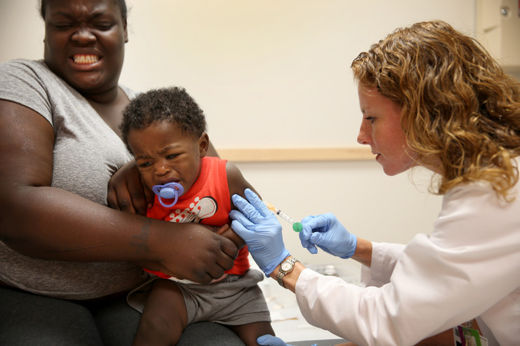
Combining two common childhood vaccines into one - rather than administering them separately - doubles the risk of febrile seizures in children, a study published in the Canadian Medical Association Journal has found.
Febrile seizures, convulsions brought on by fever in infants or young children, are a rare side-effect of measles-mumps-rubella vaccine, occurring at a rate of less than two seizures per 10,000 doses. When the MMR vaccine is combined with the vaccine against chickenpox, creating the MMRV (for varicella) vaccine, that risk doubles. It still remains relatively small, however - at a rate of 3.52 seizures per 10,000 doses, according to the study by a team led by Dr. Shannon MacDonald at the University of Calgary's faculty of medicine. Seizures among high-risk children were not significantly different, the study also found.
In British Columbia, the doubled MMRV vaccine is not given to babies because of the higher risk of febrile seizures, according to Dr. Monika Naus, the medical director of immunization programs for the B.C. Centre for Disease Control.
In July B.C. will begin administering the MMRV as a second dose to school-aged children who have already had separate vaccines against measles-mumps-rubella and chickenpox. But those children are at no risk because febrile seizures are a factor only in babies, Naus said.
Febrile seizures rarely have long-term effects, MacDonald said, but they do cause distress "and may undermine confidence in immunization programs."
Comment: Distress! Wow yah think?! Confidence in immunization programs are already declining at a rapid rate, read the following to learn more:
And that is a big worry.
At a time when measles, which had been eradicated in North America, is seeing a record resurgence, anything with the potential to reduce vaccination rates further is studied carefully by public health officials. A growing anti-vaccine movement has led to pockets of lower vaccination rates across North America.
In fact, the combined measles-mumps-rubella-varicella vaccine was adopted in some regions - although not in Ontario for the first dose children receive - to address waning vaccine rates.
There are good reasons to use the combined vaccine, MacDonald said.
"Combining MMR and varicella into a single vaccine decreases pain for children and distress for parents, thus addressing common barriers to vaccine uptake and may improve vaccination coverage levels and decrease immunization delivery costs."Deciding whether to offer separate vaccines or a combination is, ultimately, a policy decision, said MacDonald, whose findings were consistent with a study on the U.S. version of the vaccine.
The U.S. findings led its Advisory Committee on Immunization Practices to withdraw its preference for use of the combination vaccine for the first dose (usually administered to children at about 12 months). The committee advised health officials and parents to discuss the benefits and risks of each option before choosing. If there is no preference, it recommends the separate vaccines be given for the first dose in young children (12-47 months) and the combined vaccine be given to older children or those getting a second dose.
Naus said when the U.S. findings came out the BCCDC chose to not institute a combined vaccine for babies. But it decided in 2012 to administer the combination to children ages 4-6 at the beginning of school starting in 2014.
The findings come as B.C. suffers through a resurgence of measles, particularly in the upper Fraser Valley because of parental resistance to vaccinations.



Comment: Still unsure about the alleged safety of vaccinations? The following articles will shine some light on WHY parental resistance to vaccinations is growing: